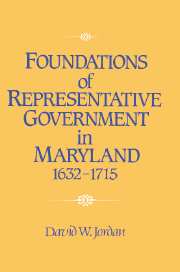Book contents
- Frontmatter
- Contents
- Acknowledgments
- Introduction: “For the Good and Happy Government” of Maryland
- Part I “In the Infancy of This Plantation”: 1632–1660
- Part II “Lord Baltimore's Politick Maximes”: 1660–1689
- Part III “Wee Your Majesties Most Humble and Loyall Subjects”: 1689–1715
- 5 “By the Name of the Country Borne”
- 6 “We More Immediately Represent the People”
- Epilogue: “Our Present Happy Protestant Constitution”
- Appendixes
- A Note on the Sources
- Index
5 - “By the Name of the Country Borne”
Published online by Cambridge University Press: 14 September 2009
- Frontmatter
- Contents
- Acknowledgments
- Introduction: “For the Good and Happy Government” of Maryland
- Part I “In the Infancy of This Plantation”: 1632–1660
- Part II “Lord Baltimore's Politick Maximes”: 1660–1689
- Part III “Wee Your Majesties Most Humble and Loyall Subjects”: 1689–1715
- 5 “By the Name of the Country Borne”
- 6 “We More Immediately Represent the People”
- Epilogue: “Our Present Happy Protestant Constitution”
- Appendixes
- A Note on the Sources
- Index
Summary
The Natives who are ignorant, and raw in busieness, and naturally proude, and obstinate, are not only the Representatives in Assembly, but the Justices of the County Courts: and by the name of the Country borne, distinguish themselves from the rest of her Majestys Subjects, and run into great heats and divisions, which may be of ill Consequence; for as they know little of the laws and good Manners they practice less.
Governor John Seymour to Board of Trade, March 10, 1708/9The people of Maryland would much rather have their cures supply'd by Persons of their own country whom they know, than by Strangers of whom they are not Known but are always Jealous that they come amongst them for no other End than to make purse and then Return home.
“Memorial Representing the Necessity of Constituting a Suffragan Bishop in Maryland”During the years of royal authority in Maryland from 1689 to 1715, dramatic changes occurred in the size and profile of the colony's population. Both Marylanders and outside observers noted the appearance of a sizable native-born population. Originally peopled primarily by young, single, white males, Maryland came to encompass a more natural proportion of women and a broader spectrum of age groups. In this quarter century the population was growing at an average rate of 2.5 percent per year and becoming more diversified, Africans or their descendants comprising almost one-third of the population and other Europeans, particularly those of Irish and Germanic stock, also now more numerous.
- Type
- Chapter
- Information
- Foundations of Representative Government in Maryland, 1632–1715 , pp. 141 - 182Publisher: Cambridge University PressPrint publication year: 1988



